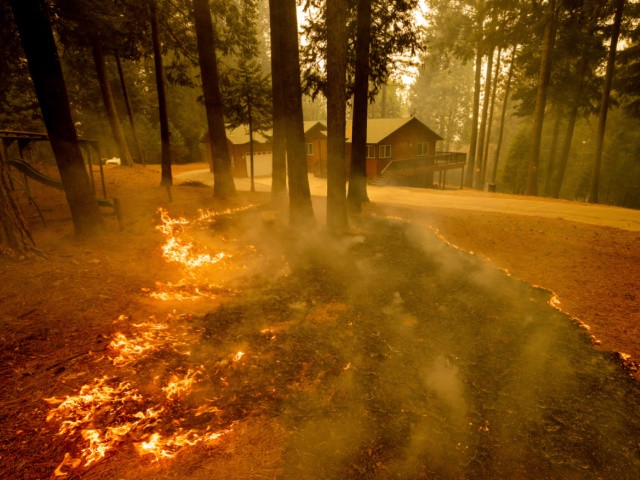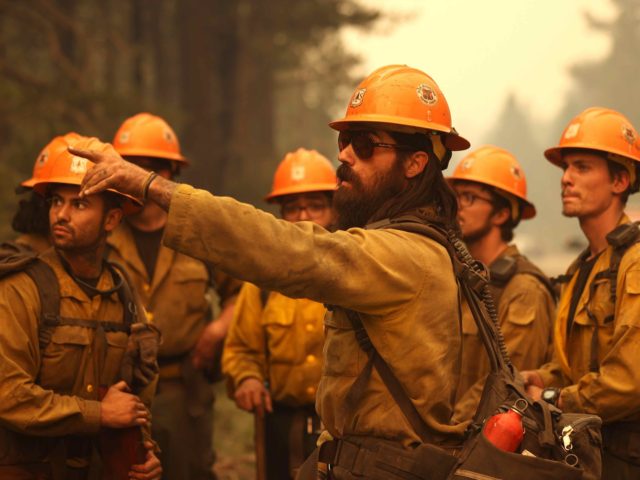Firefighters appear to have saved Lake Tahoe communities from the fast-moving Caldor Fire, thanks to a new tactic of clearing firebreaks further away from the advancing blaze, and a change in weather that eased the hot, windy conditions.

Flames from the Caldor Fire scorch the ground near a structure in Grizzly Flats, Calif., Wednesday, Aug. 18, 2021. (AP Photo/Ethan Swope)
The San Francisco Chronicle noted:
The answer is as old as firefighting itself: adapt.
And that’s exactly what the 4,662 firefighters battling the voracious Caldor Fire have been doing for the three weeks it’s been laying waste to Sierra Nevada slopes on its march toward Lake Tahoe.
They’re jumping farther ahead of the blaze, aggressively clearing space around homes in hamlets like Christmas Valley south of the lake well before the flames get there. For the first time in Northern California, they’re using infrared-capable helicopters to drop water at night. And at ski resorts they’re firing snow-making water cannons to wet the ground and buildings — a fairly new technique that’s never been used to this extent before here.
The Los Angeles Times added that fire clearance in recent years also helped:
The Forest Service partnered with the Sierra Nevada Conservancy on a project that called for 8,800 acres to be burned in the Caples Creek drainage over 10 to 15 years starting in 2017. The project included the 3,435-acre Caples prescribed burn in 2019, which was declared a wildfire after winds picked up and it burned at a higher intensity than intended, requiring suppression resources to be called in.
Like many Western U.S. forests, the watershed once benefited from frequent, low-intensity fires caused by lightning and Indigenous burning practices, experts say. But after colonization and aggressive fire suppression tactics upended that cycle, with the imbalance compounded by drought and climate change, the forest there was infilled with smaller trees and understory vegetation that increased drought stress on larger trees, according to the Forest Service. These so-called ladder fuels can also carry fire up into the canopy, helping it burn hotter and spread more quickly.
By thinning tree density and reducing the amount of smaller trees and vegetation, authorities had hoped to lessen the intensity of future wildfires that moved through the area.
Firefighters also worked throughout the week to divert the fire into areas that had previously burned, or had less vegetation.

MEYERS, CALIFORNIA – AUGUST 31: U.S. Forest Service firefighters prepare to battle the Caldor Fire on August 31, 2021 in Meyers, California. The Caldor Fire has burned over 190,000 acres, destroyed hundreds of structures and is currently 16 percent contained. (Photo by Justin Sullivan/Getty Images)
The Caldor Fire has burned over 214,000 acres, and is 43% contained. Despite progress, the danger is considered ongoing. Some who were evacuated from the area are being allowed to return, though South Lake Tahoe residents are not yet.
Joel B. Pollak is Senior Editor-at-Large at Breitbart News and the host of Breitbart News Sunday on Sirius XM Patriot on Sunday evenings from 7 p.m. to 10 p.m. ET (4 p.m. to 7 p.m. PT). He is the author of the recent e-book, Neither Free nor Fair: The 2020 U.S. Presidential Election. His recent book, RED NOVEMBER, tells the story of the 2020 Democratic presidential primary from a conservative perspective. He is a winner of the 2018 Robert Novak Journalism Alumni Fellowship. Follow him on Twitter at @joelpollak.

COMMENTS
Please let us know if you're having issues with commenting.